relay ISUZU TROOPER 1998 Service Repair Manual
[x] Cancel search | Manufacturer: ISUZU, Model Year: 1998, Model line: TROOPER, Model: ISUZU TROOPER 1998Pages: 3573, PDF Size: 60.36 MB
Page 1720 of 3573
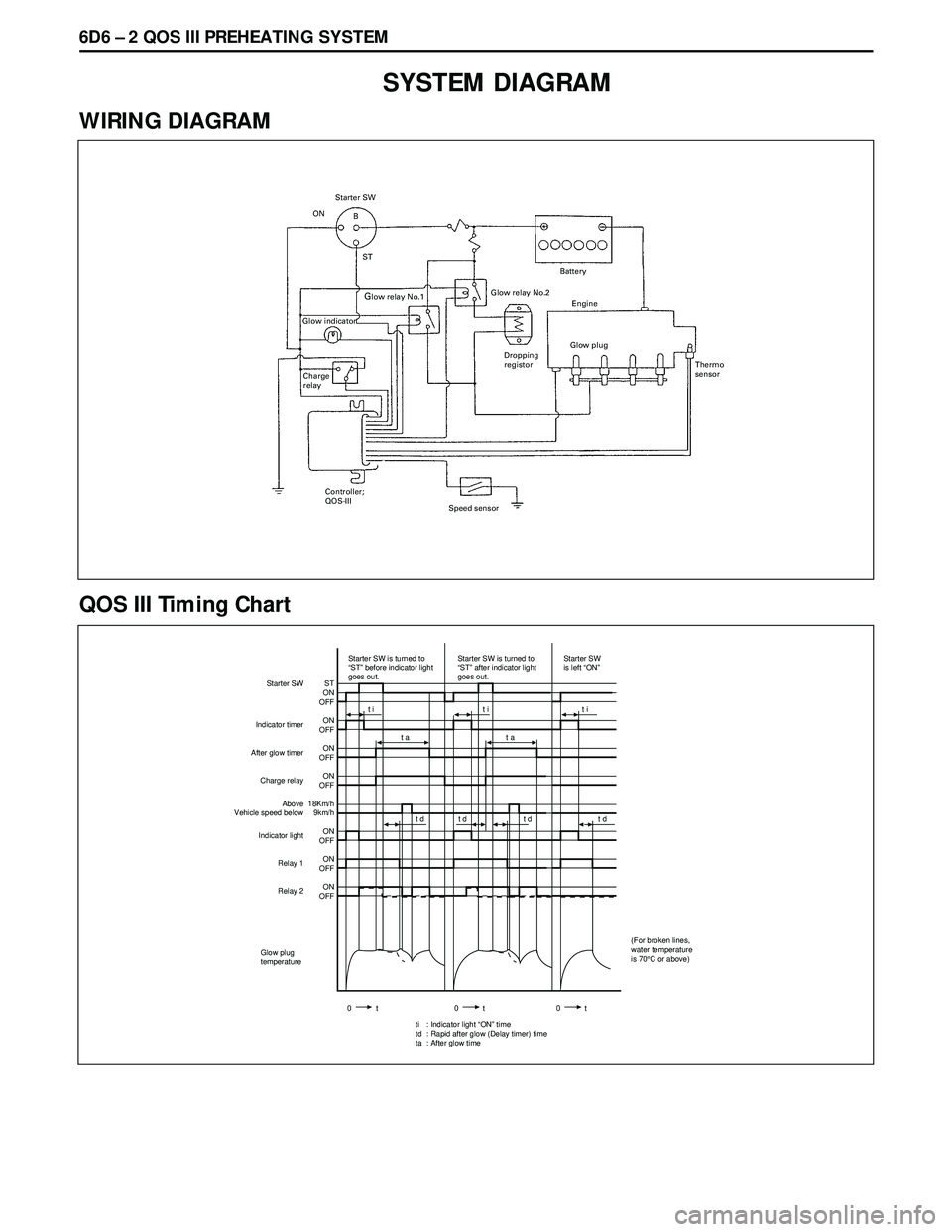
6D6 Ð 2 QOS III PREHEATING SYSTEM
SYSTEM DIAGRAM
WIRING DIAGRAM
ON
B
ST
Glow relay No.1 Starter SW
Battery
Engine Glow relay No.2
Glow indicator
Charge
relayGlow plug
Thermo
sensor
Controller;
QOS-III
Speed sensorDropping
registor
QOS III Timing Chart
ST
ON
OFF
ON
OFF
ON
OFF
ON
OFF
18Km/h
9km/h
ON
OFF
ON
OFF
ON
OFF Starter SW
Starter SW is turned to
“ST” before indicator light
goes out.Starter SW is turned to
“ST” after indicator light
goes out.Starter SW
is left “ON”
Indicator timer
After glow timer
Charge relay
Indicator light
Relay 1
Relay 2Above
Vehicle speed below
t i t i t i
t a t a
t d t d t d t d
Glow plug
temperature
0t 0t 0t
: Indicator light “ON” time
: Rapid after glow (Delay timer) time
: After glow time
ti
td
ta
(For broken lines,
water temperature
is 70¡C or above)
Page 1722 of 3573
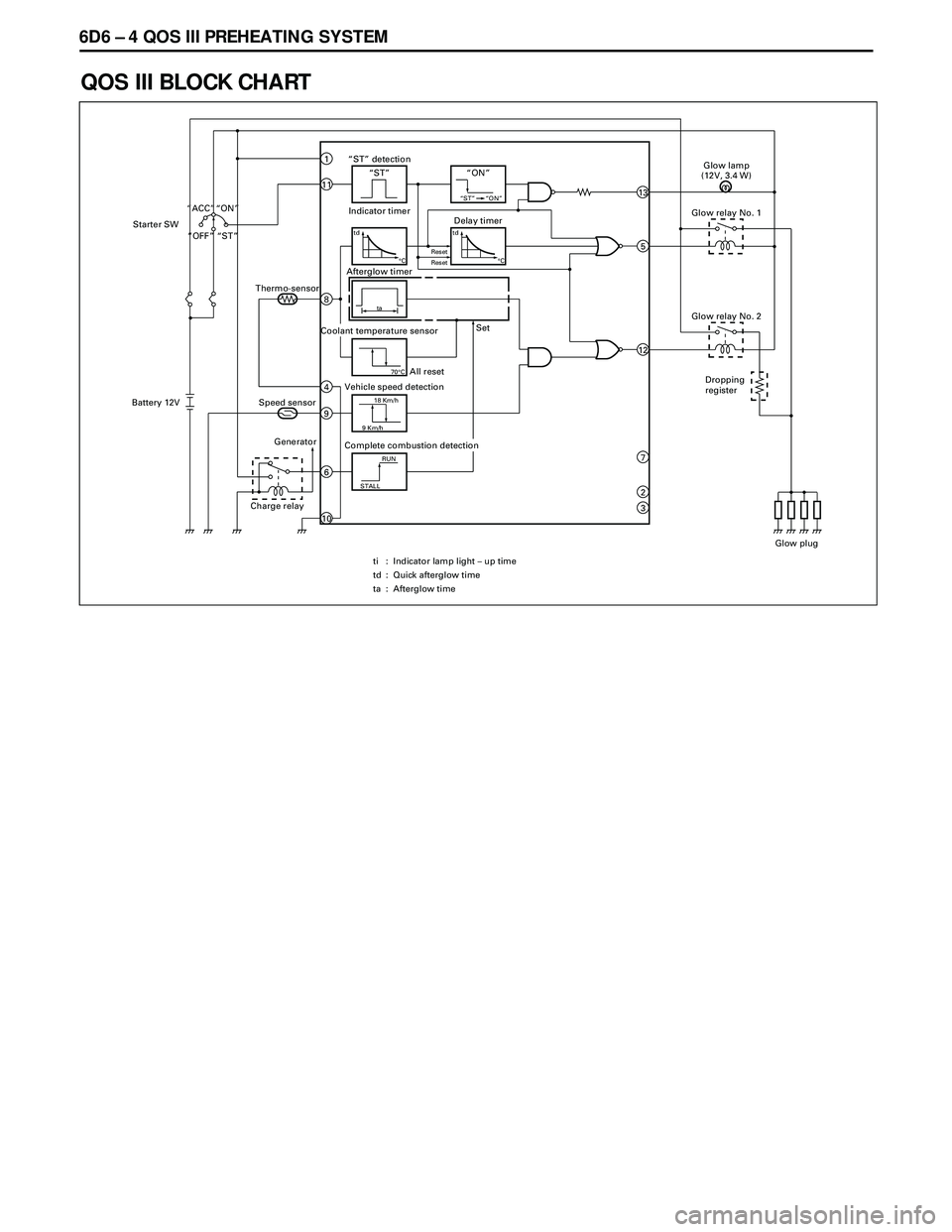
6D6 Ð 4 QOS III PREHEATING SYSTEM
QOS III BLOCK CHART
“ST” detection“ST”
Indicator timer
11
1“ON”
“ST” “ON”13
tdDelay timer
¡C
td
¡CResetReset5
ta
Afterglow timer
Coolant temperature sensor
70¡CAll reset
12
Vehicle speed detection
9 Km/h18 Km/h
Complete combustion detection
STALLRUN
Set 8
4
9
6
10
Thermo-sensor
Speed sensor
Generator
Charge relay
Glow relay No. 1
Glow lamp
(12V, 3.4 W)
Glow relay No. 2
Glow plug
Battery 12VStarter SW
“OFF” “ST” “ACC” “ON”
: Indicator lamp light – up time
: Quick afterglow time
: Afterglow time ti
td
ta7
2
3
Dropping
register
Page 1723 of 3573
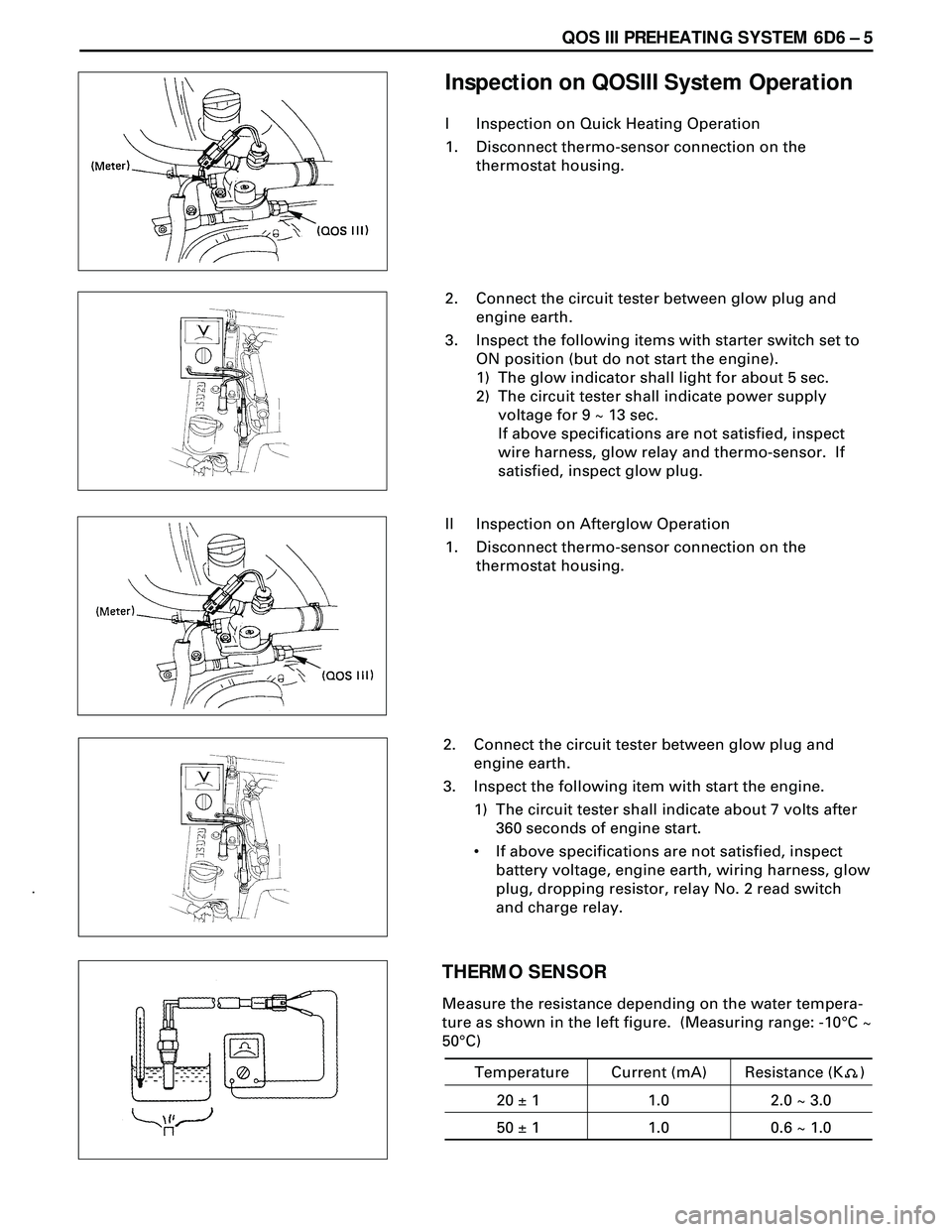
QOS III PREHEATING SYSTEM 6D6 Ð 5
Inspection on QOSIII System Operation
I Inspection on Quick Heating Operation
1. Disconnect thermo-sensor connection on the
thermostat housing.
2. Connect the circuit tester between glow plug and
engine earth.
3. Inspect the following items with starter switch set to
ON position (but do not start the engine).
1) The glow indicator shall light for about 5 sec.
2) The circuit tester shall indicate power supply
voltage for 9 ~ 13 sec.
If above specifications are not satisfied, inspect
wire harness, glow relay and thermo-sensor. If
satisfied, inspect glow plug.
II Inspection on Afterglow Operation
1. Disconnect thermo-sensor connection on the
thermostat housing.
2. Connect the circuit tester between glow plug and
engine earth.
3. Inspect the following item with start the engine.
1) The circuit tester shall indicate about 7 volts after
360 seconds of engine start.
¥ If above specifications are not satisfied, inspect
battery voltage, engine earth, wiring harness, glow
plug, dropping resistor, relay No. 2 read switch
and charge relay.
THERMO SENSOR
Measure the resistance depending on the water tempera-
ture as shown in the left figure. (Measuring range: -10¡C ~
50¡C)
Current (mA)
20 ± 1 1.0
50 ± 1Resistance (K )
1.0
2.0 ~ 3.0
0.6 ~ 1.0 Temperature
Page 1724 of 3573
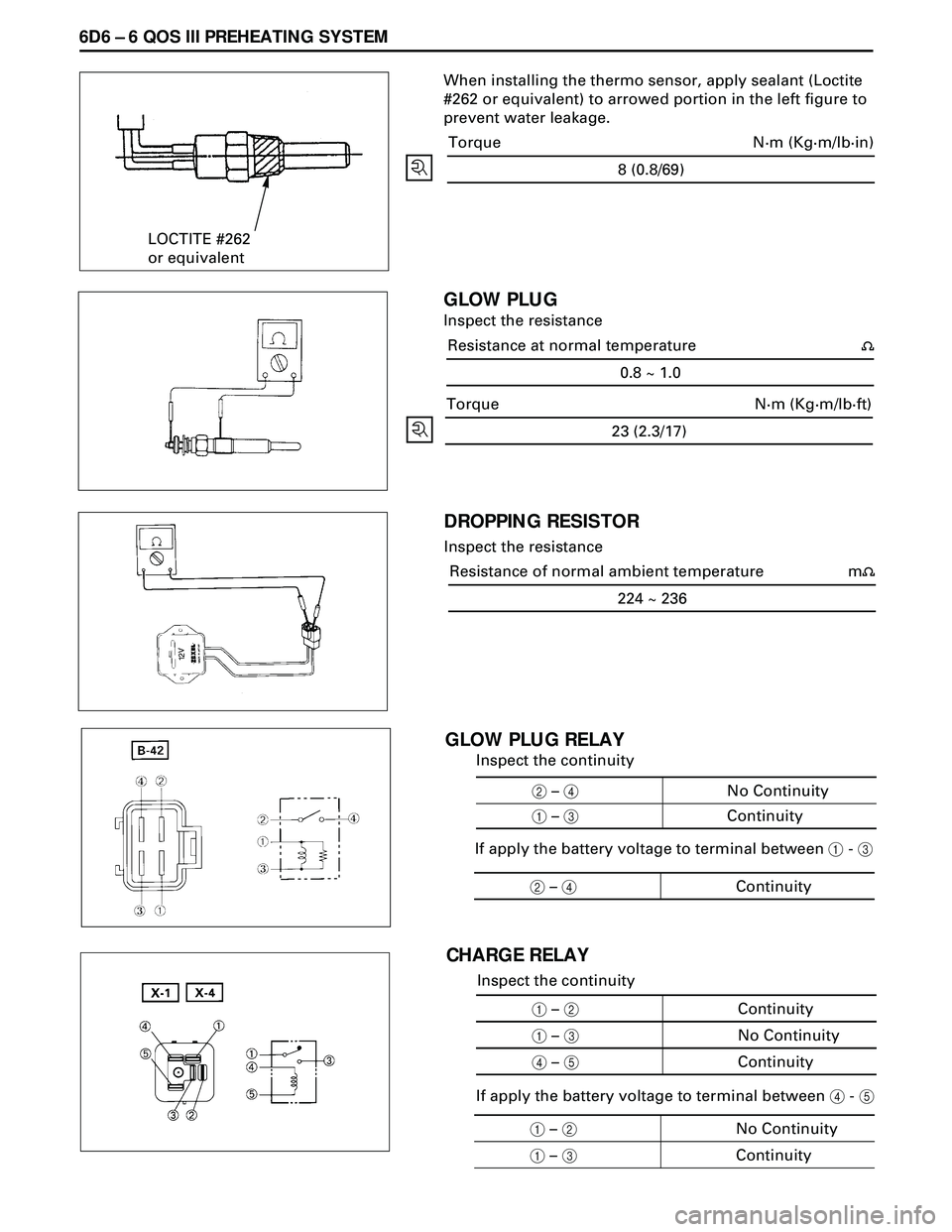
6D6 Ð 6 QOS III PREHEATING SYSTEM
8 (0.8/69)
Torque N·m (Kg·m/lb·in)
23 (2.3/17)
Torque N·m (Kg·m/lb·ft)
0.8 ~ 1.0
Resistance at normal temperature
LOCTITE #262
or equivalentWhen installing the thermo sensor, apply sealant (Loctite
#262 or equivalent) to arrowed portion in the left figure to
prevent water leakage.
GLOW PLUG
Inspect the resistance
No Continuity 2 –4
Continuity 1 –3
Continuity 2 –4
Continuity 1 –2
No Continuity 1 –3
Continuity 4 –5
No Continuity 1 –2
Continuity 1 –3
224 ~ 236
Resistance of normal ambient temperature m
DROPPING RESISTOR
Inspect the resistance
GLOW PLUG RELAY
Inspect the continuity
If apply the battery voltage to terminal between 1 - 3
CHARGE RELAY
Inspect the continuity
If apply the battery voltage to terminal between 4 - 5
Page 1746 of 3573
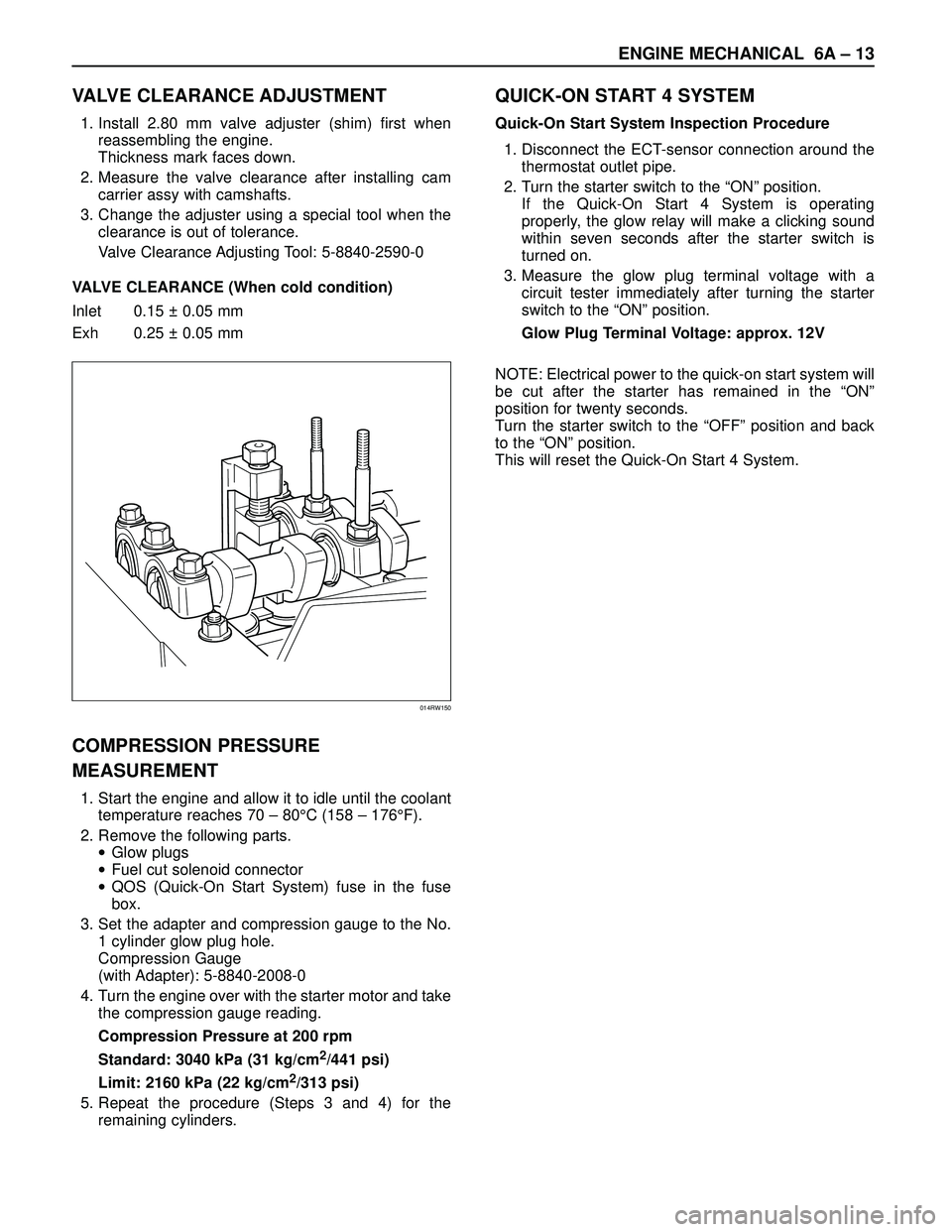
ENGINE MECHANICAL 6A – 13
VALVE CLEARANCE ADJUSTMENT
1. Install 2.80 mm valve adjuster (shim) first when
reassembling the engine.
Thickness mark faces down.
2. Measure the valve clearance after installing cam
carrier assy with camshafts.
3. Change the adjuster using a special tool when the
clearance is out of tolerance.
Valve Clearance Adjusting Tool: 5-8840-2590-0
VALVE CLEARANCE (When cold condition)
Inlet 0.15 ± 0.05 mm
Exh 0.25 ± 0.05 mm
COMPRESSION PRESSURE
MEASUREMENT
1. Start the engine and allow it to idle until the coolant
temperature reaches 70 – 80°C (158 – 176°F).
2. Remove the following parts.
•Glow plugs
•Fuel cut solenoid connector
•QOS (Quick-On Start System) fuse in the fuse
box.
3. Set the adapter and compression gauge to the No.
1 cylinder glow plug hole.
Compression Gauge
(with Adapter): 5-8840-2008-0
4. Turn the engine over with the starter motor and take
the compression gauge reading.
Compression Pressure at 200 rpm
Standard: 3040 kPa (31 kg/cm
2/441 psi)
Limit: 2160 kPa (22 kg/cm
2/313 psi)
5. Repeat the procedure (Steps 3 and 4) for the
remaining cylinders.
QUICK-ON START 4 SYSTEM
Quick-On Start System Inspection Procedure
1. Disconnect the ECT-sensor connection around the
thermostat outlet pipe.
2. Turn the starter switch to the “ON” position.
If the Quick-On Start 4 System is operating
properly, the glow relay will make a clicking sound
within seven seconds after the starter switch is
turned on.
3. Measure the glow plug terminal voltage with a
circuit tester immediately after turning the starter
switch to the “ON” position.
Glow Plug Terminal Voltage: approx. 12V
NOTE: Electrical power to the quick-on start system will
be cut after the starter has remained in the “ON”
position for twenty seconds.
Turn the starter switch to the “OFF” position and back
to the “ON” position.
This will reset the Quick-On Start 4 System.
014RW150
Page 1872 of 3573
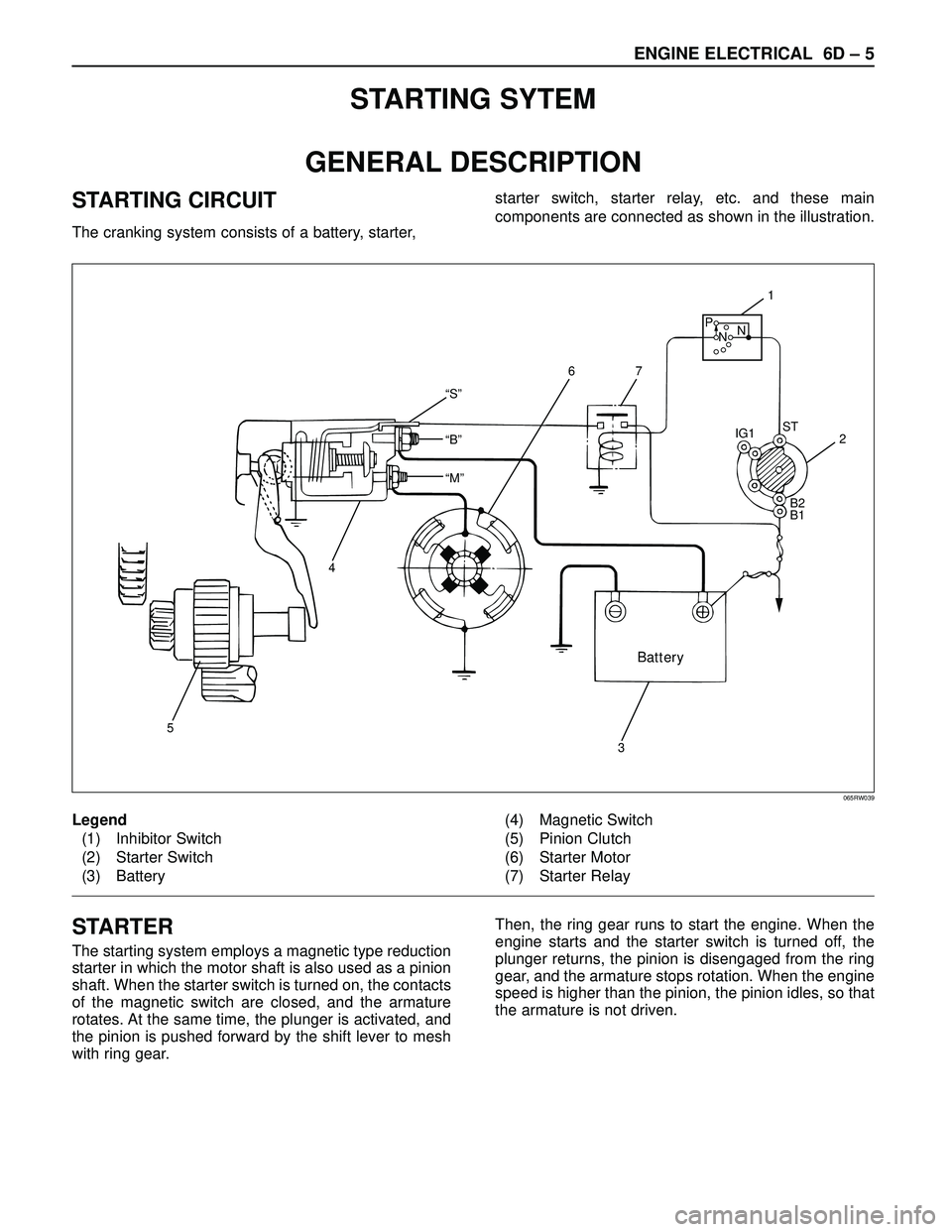
ENGINE ELECTRICAL 6D – 5
STARTING SYTEM
GENERAL DESCRIPTION
STARTING CIRCUIT
The cranking system consists of a battery, starter, starter switch, starter relay, etc. and these main
components are connected as shown in the illustration.
“S”
“B”
“M”
Battery
5
4
32 IG1ST
B2
B1
1
76
P
NN
Legend
(1) Inhibitor Switch
(2) Starter Switch
(3) Battery(4) Magnetic Switch
(5) Pinion Clutch
(6) Starter Motor
(7) Starter Relay
065RW039
STARTER
The starting system employs a magnetic type reduction
starter in which the motor shaft is also used as a pinion
shaft. When the starter switch is turned on, the contacts
of the magnetic switch are closed, and the armature
rotates. At the same time, the plunger is activated, and
the pinion is pushed forward by the shift lever to mesh
with ring gear.Then, the ring gear runs to start the engine. When the
engine starts and the starter switch is turned off, the
plunger returns, the pinion is disengaged from the ring
gear, and the armature stops rotation. When the engine
speed is higher than the pinion, the pinion idles, so that
the armature is not driven.
Page 1873 of 3573
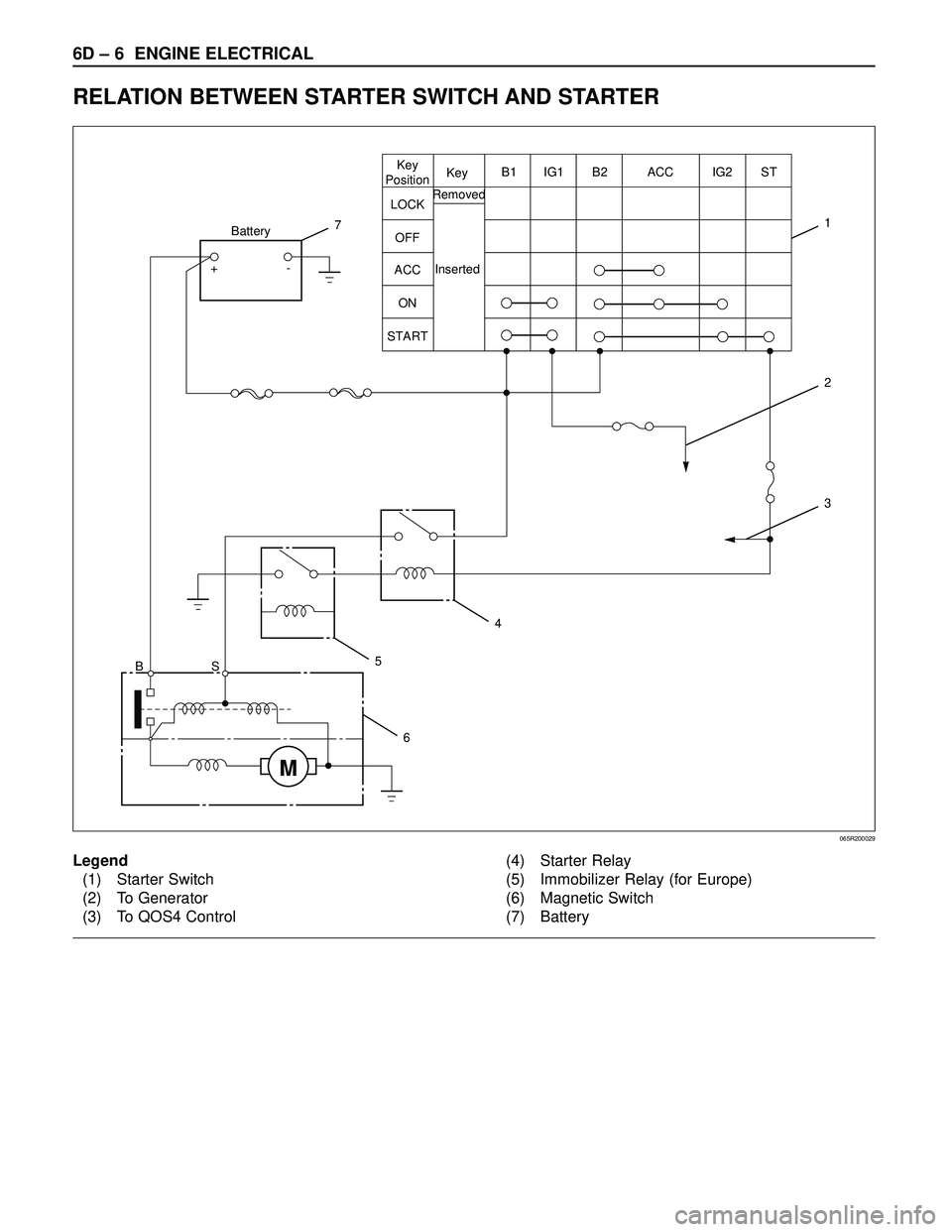
6D – 6 ENGINE ELECTRICAL
RELATION BETWEEN STARTER SWITCH AND STARTER
M
Key
PositionB1 B2 ACCIG1 IG2 ST
LOCKKey
Removed
Inserted OFF
ACC
ON
START
BSBattery
+-
2
17
3
4
5
6
Legend
(1) Starter Switch
(2) To Generator
(3) To QOS4 Control(4) Starter Relay
(5) Immobilizer Relay (for Europe)
(6) Magnetic Switch
(7) Battery
065R200029
Page 1874 of 3573
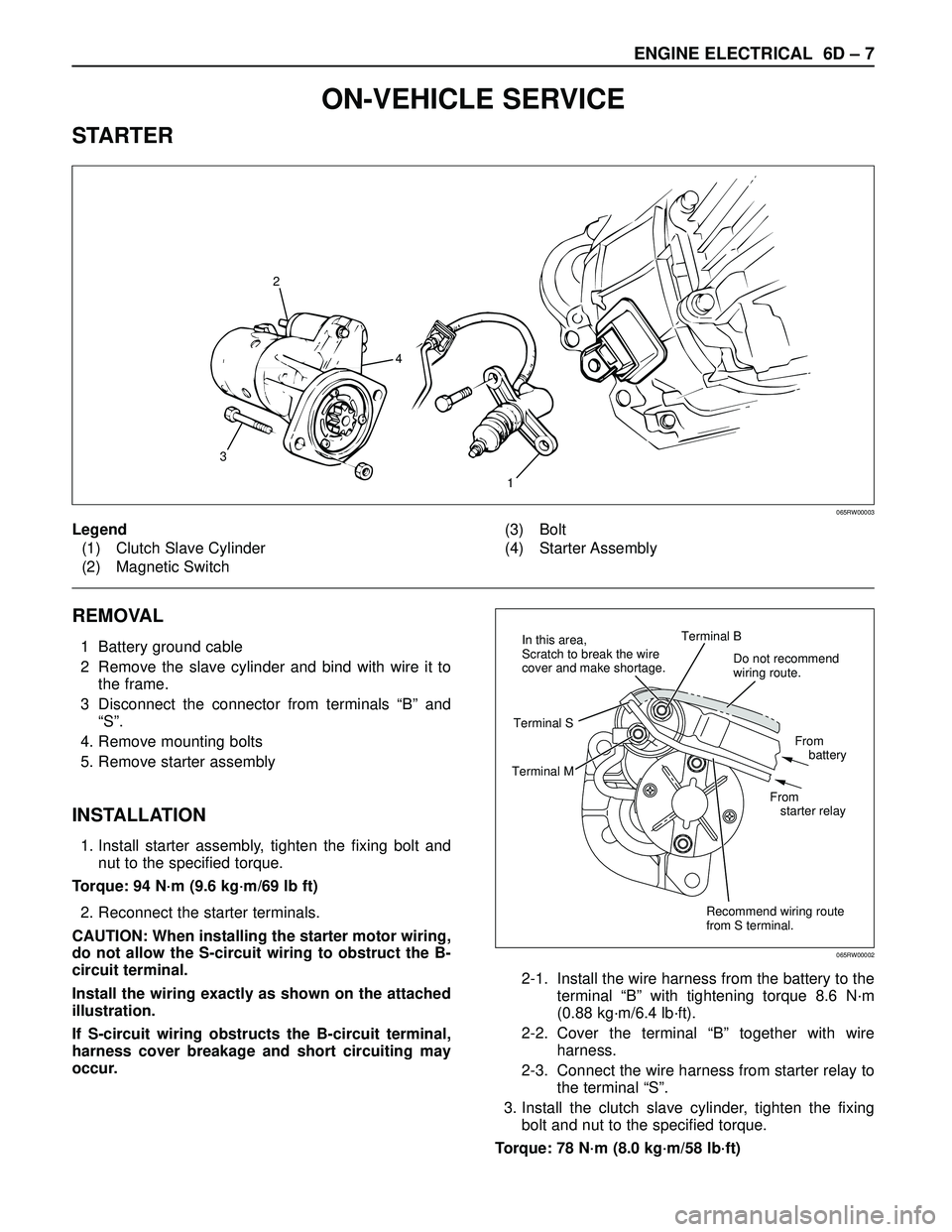
ENGINE ELECTRICAL 6D – 7
ON-VEHICLE SERVICE
STARTER
REMOVAL
1 Battery ground cable
2 Remove the slave cylinder and bind with wire it to
the frame.
3 Disconnect the connector from terminals “B” and
“S”.
4. Remove mounting bolts
5. Remove starter assembly
INSTALLATION
1. Install starter assembly, tighten the fixing bolt and
nut to the specified torque.
Torque: 94 N·m (9.6 kg·m/69 lb ft)
2. Reconnect the starter terminals.
CAUTION: When installing the starter motor wiring,
do not allow the S-circuit wiring to obstruct the B-
circuit terminal.
Install the wiring exactly as shown on the attached
illustration.
If S-circuit wiring obstructs the B-circuit terminal,
harness cover breakage and short circuiting may
occur.2-1. Install the wire harness from the battery to the
terminal “B” with tightening torque 8.6 N·m
(0.88 kg·m/6.4 lb·ft).
2-2. Cover the terminal “B” together with wire
harness.
2-3. Connect the wire harness from starter relay to
the terminal “S”.
3. Install the clutch slave cylinder, tighten the fixing
bolt and nut to the specified torque.
Torque: 78 N·m (8.0 kg·m/58 lb·ft)
1
32
4
Legend
(1) Clutch Slave Cylinder
(2) Magnetic Switch(3) Bolt
(4) Starter Assembly
065RW00003
Do not recommend
wiring route.
Recommend wiring route
from S terminal.From
battery
From
starter relay Terminal B
Terminal MTerminal SIn this area,
Scratch to break the wire
cover and make shortage.
065RW00002
Page 1882 of 3573
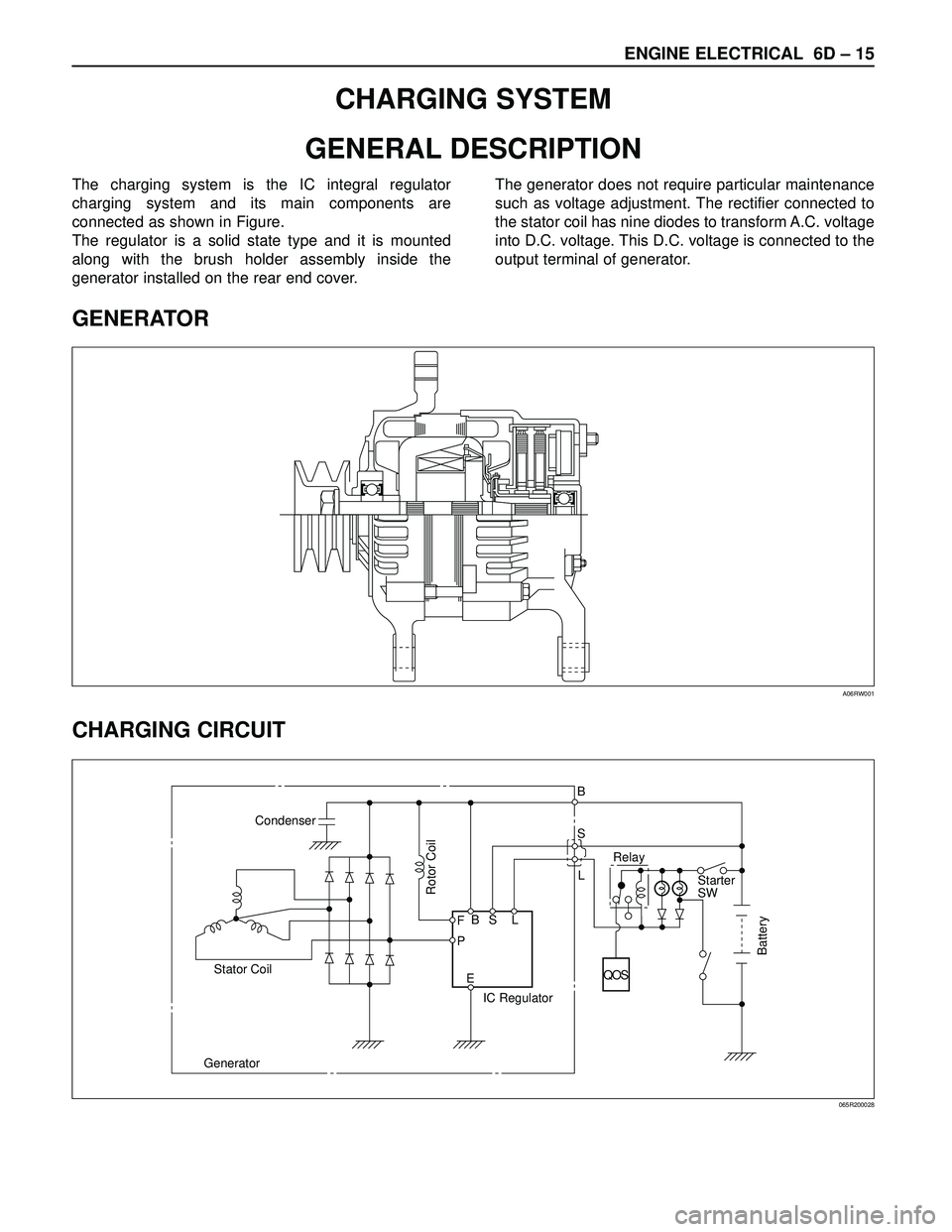
ENGINE ELECTRICAL 6D – 15
CHARGING SYSTEM
GENERAL DESCRIPTION
GENERATOR
CHARGING CIRCUIT
The charging system is the IC integral regulator
charging system and its main components are
connected as shown in Figure.
The regulator is a solid state type and it is mounted
along with the brush holder assembly inside the
generator installed on the rear end cover.The generator does not require particular maintenance
such as voltage adjustment. The rectifier connected to
the stator coil has nine diodes to transform A.C. voltage
into D.C. voltage. This D.C. voltage is connected to the
output terminal of generator.
A06RW001
Condenser
GeneratorStator Coil
IC RegulatorStarter
SW
Rotor Coil
Battery
P F
EBS LRelay B
S
L
QOS
065R200028
Page 1883 of 3573
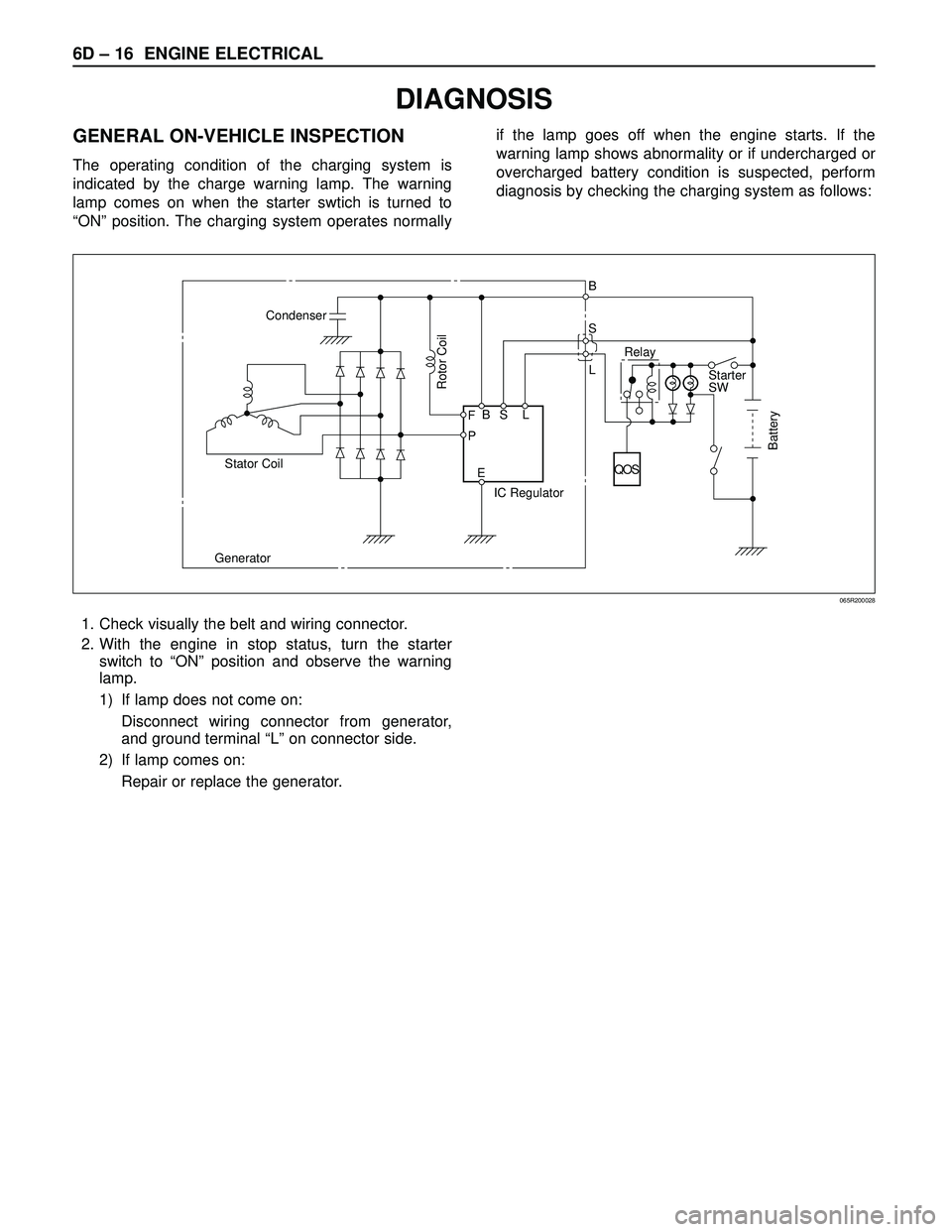
6D – 16 ENGINE ELECTRICAL
DIAGNOSIS
GENERAL ON-VEHICLE INSPECTION
The operating condition of the charging system is
indicated by the charge warning lamp. The warning
lamp comes on when the starter swtich is turned to
“ON” position. The charging system operates normallyif the lamp goes off when the engine starts. If the
warning lamp shows abnormality or if undercharged or
overcharged battery condition is suspected, perform
diagnosis by checking the charging system as follows:
Condenser
GeneratorStator Coil
IC RegulatorStarter
SW
Rotor Coil
Battery
P F
EBS LRelay B
S
L
QOS
065R200028
1. Check visually the belt and wiring connector.
2. With the engine in stop status, turn the starter
switch to “ON” position and observe the warning
lamp.
1) If lamp does not come on:
Disconnect wiring connector from generator,
and ground terminal “L” on connector side.
2) If lamp comes on:
Repair or replace the generator.